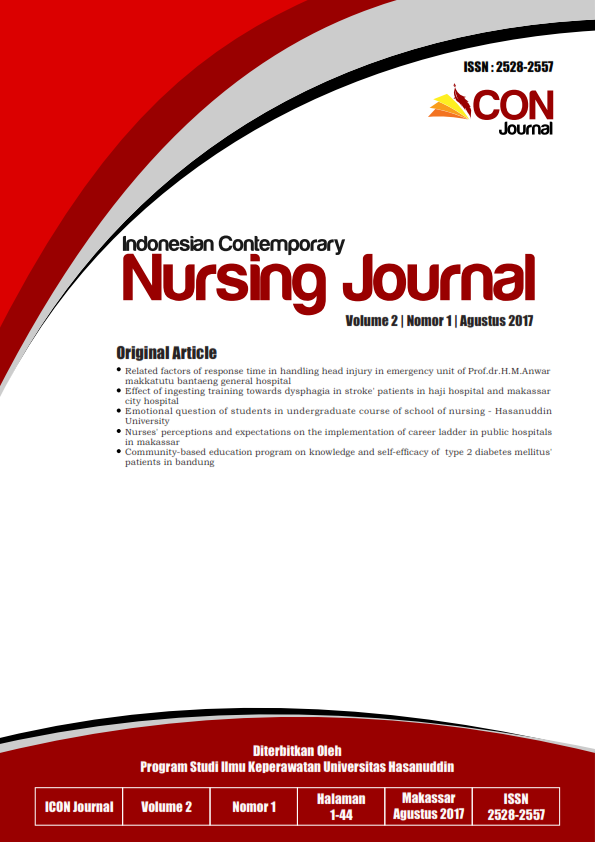Effect of Ingesting Training Towards Dysphagia in Stroke’ Patients in Haji Hospital and Makassar City Hospital
DOI:
https://doi.org/10.20956/icon.v2i1.3580Abstract
Introduction: Stroke is a loss of brain function caused by the cessation of blood supply to the brain. One of the most common clinical disorders of stroke is ingesting or dysphagia. This study aims to identify the effect of ingesting exercise to stroke patients with dysphagia in the General Hospital of Haji General Hospital of Makassar City. Method: The design of this study was pre experimental with One Group Pre-Post Test Design. Samples in this study were all stroke patients with dysphagia with Convenience Sampling technique, obtained 20 respondents. Rehabilitation of ingesting exercise is done three times a day at breakfast, lunch, and dinner for seven days in a row. Evaluation of respondents' ingesting status was done on the first day before exercise and last day after practicing exercise. Result: Bivariate results showed that there was an influence between stroke patients with dysphagia and ingesting exercises (p <0.001). Conclusion: It is further recommended that nurses perform structured ingesting exercises as self-care nursing intervention in dealing with stroke patients who have dysphagia.References
Jenny, J.C. Lidwina, S. and Angliadi, E. (2014). Rehabilitasi Medik pada Penderita Disfagia. Jurnal Biomedik (JBM). Vol. 6. No. 3. November 2014. Dipetik Oktober 12, 2016 dari ejournal.unsrat.ac.id/index.php/biomedik/article/download/6321/5841 pukul 16.00 WITA
Ismansyah. (2008). Pengaruh Latihan Mengunyah dan Menelan Terstruktur Terhadap Kemampuan Mengunyah dan Menelan Dalam Konteks Asuhan Keperawatan Pada Pasien Stroke dengan Disfagia di RSUD Abdul Wahab Sjahranie Samarinda. Skripsi diterbitkan. Depok : Fakultas Kedokteran – Universitas Indonesia. Diakses dari lib.ui.ac.id/file?file=digital/127168...Pengaruh%20latihan-HA.pdf
Kemenkes. (2016). Diakses dari www.antarasulsel.com/berita/55730/prevalensi-ptm-di-makassar lampaui-prevalensi-nasional. Pada tanggal 19 Oktober 2016 pukul 04.00 WITA
McCullough, G & Kim, Y. (2013). Effect of the Mendelsohn Maneuver on Extent of Hyoid Movement and UES Opening Post-Stroke1. NIH Public Access. Vol. 28. No. 4. Dipetik November 8, 2016. DOI : doi:10.1007/s00455-013-9461-1. pukul 19.00 WITA
Mulyatsih , Enny & Ahmad, Airiza. (2015). Petunjuk Perawatan Pasien Pasca Stroke di Rumah. Jakarta: FKUI.
Rani, Parkodi, & Seethalakshmi. (2013). Effectiveness of Dysphagia Exercises on
Swallowing Ability Among Patients with CVA. Journal of Science. Vol 3. Issue 2. 76. Dipetik October, 14, 2016. DOI: www.journalofscience.net. pukul 16.15 WITA.
Rasyid, Al & Soertidewi, Lyna. (2011). Manajemen Stroke secara Komprehensif. Jakarta: FKUI.
Rasyid, Misbach, & Harris. (2015). Komplikasi Medis & Tata Laksana. Jakarta: FKUI.
Riskesdas. (2013). Diakses dari Riset kesehatan dasar. Diakses dari www.depkes.go.id/resources/download/general/Hasil%20Riskesdas%202013. Pada tanggal 12 Oktober 2016 pukul 16.45 WITA
Smithard, David G. (2014). Swallowing Rehabilitation After Stroke. Int J Phys Med Rehabil, 2(2), 2-8. Dipetik Oktober 12, 2016, dari http://dx.doi.org/10.4172/2329-9096.1000191 pukul 16.31 WITA
Squires, N. (2006). Dysphagia Management of Progressive Neurological Conditions, Neuroscience. Nursing Journal. (Vol. 20) http://proquest.umi.com/pqdweb?index=190&did=1020191231. Diakses tanggal 19 Januari 2017
Downloads
Published
How to Cite
Issue
Section
License
Authors who publish with this journal agree to the following terms:Authors retain copyright and grant the journal right of first publication with the work simultaneously licensed under a Creative Commons Attribution License that allows others to share the work with an acknowledgement of the work's authorship and initial publication in this journal.
Authors are able to enter into separate, additional contractual arrangements for the non-exclusive distribution of the journal's published version of the work (e.g., post it to an institutional repository or publish it in a book), with an acknowledgement of its initial publication in this journal.
Authors are permitted and encouraged to post their work online (e.g., in institutional repositories or on their website) prior to and during the submission process, as it can lead to productive exchanges, as well as earlier and greater citation of published work (See The Effect of Open Access).



